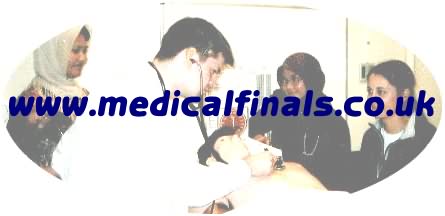| Medical Finals contents: Welcome Finals advice Written exams Clinical revision X-Rays Mock final OSCE's |  |
Medical Finals contents: Monthly quiz PDA's Links Credits Your comments Who are we? |
(For more detail please see: Assessment of the Acutely Ill Patient, by Jon Silversides.)
Basic Life Support (BLS):
Call for Help
A: Head tilt + chin lift/jaw thrust. Clear mouth.
B: If not breathing - give 2 breaths
C: If no pulse - give 15 chest compressions at 100/minute, per 2 breaths.
Advanced Life Support (ALS):
If witnessed arrest - give Precordial thump.
BLS.
Attach defib/monitor.
If VF or pulseless-VT => DC Shock 200, 200, 360 joules; CPR 1 minute; reaccess rhythm & pulse; reshock 3 x 360 joules.
If non-VF or VT-with-pulse => 3 minutes CPR; reaccess rhythm & pulse.
During CPR: correct reversible causes, IV access, give 1mg IV Adrenaline each 3 minutes, consider intubation.
Consider amiodarone, atropine, pacing, buffers.
Reversible causes:
Hypoxia
Hypovolaemia
Hypokalaemia, hyperkalaemia
Hypothermia
Tension pneumothorax
Tamponade
Toxic/therapeutic disturbance
Thromboembolic/mechanical obstruction.
Management: (BOOMASS)
Bed rest
Oxygen
Opiates
Monitor rhythm (ECG)
Aspirin (300mg) (GTN and Beta-blockers can help)
Steptokinase (if within 12hr and elevated ST, but no contraindications)
Stop smoking (exercise, diet, physio)
In more detail:
ECG Monitor
O2 (High flow)
IV Access.
FBP, U+E, Glucose, Lipids, Cardiac enzymes.
Aspirin 300mg
Morphine (5-10mg IV) or Diamorphine (2-5mg IV) + Antiemetic, eg: Metoclopramide (10mg IV)
GTN (unless hypotensive)
Beta-blocker (eg. atenolol 5mg IV, unless asthma or LVF)
Thrombolysis (Streptokinase or Alteplase, rt-PA) - if within 12 hrs (still may help upto 24 hrs) and ST elevation, BUT no internal bleeding, no surgery in past 2 weeks, BP not over 200/120mmHg, previous allergic reaction, pregnancy, don't give streptokinase if it is 5 days to 1 year since last administration. If there are thrombolysis contra-indications, consider urgent angioplasty instead.
CXR
Prophylaxis - Management of any existing Diabetis, DVT Prophylaxis
Stop Calcium channel antagonists
Signs of Severe attack:
Cannot complete sentences
Resp rate > 25/minute
Pulse > 110/minute
Peak flow < 50% of predicted or best
Signs of Life-threatening attack:
Peak flow < 33% of predicted or best
Silent chest, cyanosis, feeble respiratory effort
Bradycardia or Hypotension
Exhaustion, confusion, or coma
Normal or high PaCO2, Low PaO2, Low pH.
Treatment:
Sit patient up,
100% O2
Salbutamol (5mg) with O2
Hydrocortisone (200mg IV)
Condider Ipratropium or Aminophylline (but risk of arrhythmia side effects)
If severe, warn ITU.
CXR - exclude pneumothorax.
Symptoms & signs:
Skin: Itching, Erythema, Urticaria, Oedema.
Breathing: Wheeze, Laryngeal obstruction.
Heart: Tachycardia, Hypotension.
Management:
Secure Airway
100% Oxygen
Intubate if respiratory obstruction imminent
Adrenaline IM, 0.5ml of 1:1000 (=0.5mg), repeat each 5 minutes if needed
IV Access
Chlorpheniramine 10mg IV
Hydrocortisone 200mg IV
IV saline (eg 500ml per 15 minutes, upto 2 litres) monitoring BP.
If wheeze, treat for asthma.
May need ventilatory support, and Intensive care.
Signs & symptoms:
Polyuria, lethargy, hyperventilation, ketotic breath, dehydration, vomiting, abdominal cramp, coma.
Management:
IV access
IV Fluids (Saline 1 litre stat, 1L over 1hr, 1L over 2hr, 1L over 4hr. Careful if >65years or CCF. Dextrose saline when glucose<15mmol/L)
Plasma glucose. If > 20mmol/L give 10 units soluble insulin (actrapid) IV.
Tests: Lab glucose, U+E, HCO3, osmolality, blood gases, FBP, blood culture, urine ketones & MSU.
NG Tube if nausea/vomiting/unconscious.
Insulin sliding scale with hourly blood glucose tests.
Potassium replacement
Access for shock:
Cold nose and fingers
Slow capillary refill
Pulse>100/min
Systolic BP > 100mmHg
Urine output < 30ml/hr
If shocked:
Protect airway. Nil by mouth.
2 large cannulae.
Draw bloods (FBP, U+E, LFT, glucose, clotting screen).
Cross-match 6 units.
High-flow O2.
Rapid IV colloids (upto 1 litre).
If still shocked: group specific or O-ive blood until cross-match.
(If not still shocked and not liver failure, IV saline to keep lines open).
Correct clotting: Vit K, FFP.
Monitor vitals each 15 minutes, and urine output (>30ml/hr).
Notify surgeons (Endoscopy for diagnosis/control bleeding).
State what you would do in the following emergencies. Send 40 seconds on each question, then look at the suggested answers above.
1. Cardiac Arrest - give the Basic Life Support algorithm, Advanced Life Support algorithm, Reversible causes of cardiac arrest.
2. Myocardial Infarction - give the Management
3. Acute severe Asthma - give the Signs of severe attack, Signs of Life-threatening attack, Treatment
4. Anaphylactic Shock - give the Signs and Management
5. Diabetic Ketoacidosis - give the Signs & symptoms, and Management.
6. Acute upper GI bleed - give the Management